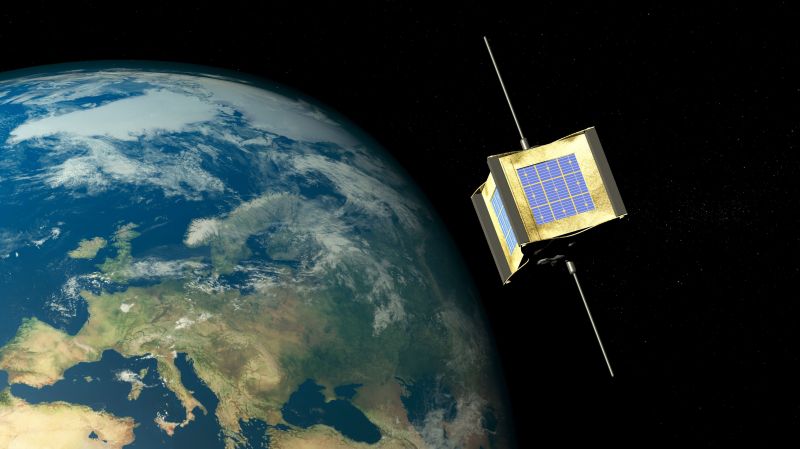Join us on Wednesday, June 21 at noon Pacific for the DIY Picosatellites Hack Chat with Nathaniel Evry!
Building a satellite and putting it in orbit was until very recently something only a nation had the resources to accomplish, and even then only a select few. Oh sure, there were a few amateur satellites that somehow managed to get built on a shoestring budget and hitch a ride into space, and while their stories are deservedly the stuff of legends, satellite construction took a very long time to be democratized.
Fast forward a half-dozen or so decades, and things have changed dramatically. Satellite launches are still complex affairs — it’s still rocket science, after all — but the advent of the CubeSat format and the increased tempo of launches, both national and commercial, has pushed the barriers to private, low-budget launches way, way down. So much so, in fact, that the phrase “space startup” is no longer something to snicker about.
 One such group of space entrepreneurs is Quub, Inc., a small company in Lancaster, Pennsylvania which is looking to build and fly a constellation of microsatellites to monitor Earth’s environment in real-time. They’re building sats and signing launch deals using consumer-grade technology and modularized construction, and we’re lucky enough to have Nathaniel Evry, their Chief Research Officer, stop by the Hack Chat. If you’ve ever wondered what it takes to build hardware that can stand the rigors of launch and then perform a task in space, you’ll want to tune in for this one.
One such group of space entrepreneurs is Quub, Inc., a small company in Lancaster, Pennsylvania which is looking to build and fly a constellation of microsatellites to monitor Earth’s environment in real-time. They’re building sats and signing launch deals using consumer-grade technology and modularized construction, and we’re lucky enough to have Nathaniel Evry, their Chief Research Officer, stop by the Hack Chat. If you’ve ever wondered what it takes to build hardware that can stand the rigors of launch and then perform a task in space, you’ll want to tune in for this one.
Our Hack Chats are live community events in the Hackaday.io Hack Chat group messaging. This week we’ll be sitting down on Wednesday, June 21 at 12:00 PM Pacific time. If time zones have you tied up, we have a handy time zone converter. Click that speech bubble to the right, and you’ll be taken directly to the Hack Chat group on Hackaday.io. You don’t have to wait until Wednesday; join whenever you want and you can see what the community is talking about.
















Quite a few amateurs have been launching picoballoons with various telemetry functions that can be easily monitored by anyone. Most don’t stay up long, but some have completed several circumnavigations of the earth. The hardware is less than $100.
Right, that reminds me of the high-altitude ballooning scene. They often carry GPS, APRS and SSTV payloads. Some also carry an high-definition camera.
“[..] Oh sure, there were a few amateur satellites that somehow managed to get built on a shoestring budget and hitch a ride into space [..]”
Thing is, these ancient birds are actually real, full-fledged satellites in an higher altitude orbit. They do have a much better coverage than the cheap Cubesats of today, which are almost all in LEO.
There was a series of OSCAR satellites that were used by hams for long range communications. Their life was limited by the power systems they had…
That’s true to my understanding. The earliest models all failed due to batteries running out of charge or missing chargers (Nickel Cadmium batteries didn’t absolutely need them at the time, so chargers weren’t used early on). The famous AO-7 is such an example. It failed due to a shorted rechargeable battery cell, essentially. And came back to life once the short was gone, the solar cells from the 1970s still work. This is interesting in so far, because the simple “HCU” (house keeping unit), as it was called in later models, was all made out of discreet TTL chips and hand wired/soldered connections (with some CMOS here and there, maybe). The transceivers, the linear transponders at the heart, are still working fine. After half a century. Personally, I think this is a testimony of quality in some way or another. The Voyager probes are of the same era, too.
The somewhat important question: who or what do you need to know to put hardware up there? When i was in the business, they were not sharing rides.
For OSCAR 1, somebody knew somebody. But rockets were going up with 1 satellite. Oscar 1 was a test case, so likely welcomed. It fit in otherwise empty space.
Because it was a success, the concept grew. By the time other groups wanted launch space, it became more formal, and due to demand, more competition.
I assume there is some NASA agency that handles it. There must be requirements. I’m sure universities get more priority.
Pretty much any launch provider carries secondary payloads these days, and some devote entire launches to small satellites. Some are picky about whose payloads they carry (e.g. US national security launches tend to only take government payloads), but a quick search for “cubesat launch service” will turn up several companies that will match your satellite up with a rocket.
is possible add to constelation outernet.us ?
I need lora repeater better than moon
https://twitter.com/OWLIntegrations/status/1669049788078120962